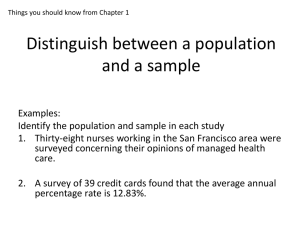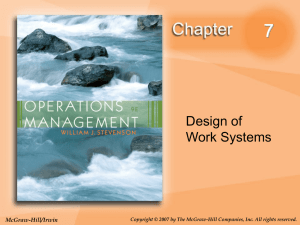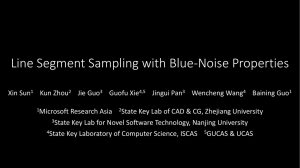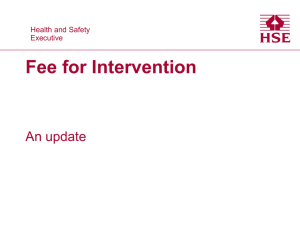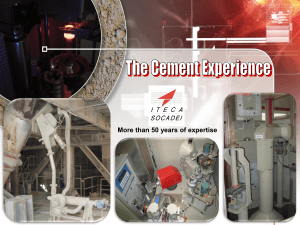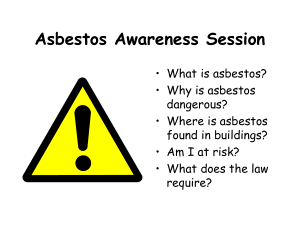OSHA Personal Air Sampling: Asbestos Exposure Assessment
advertisement
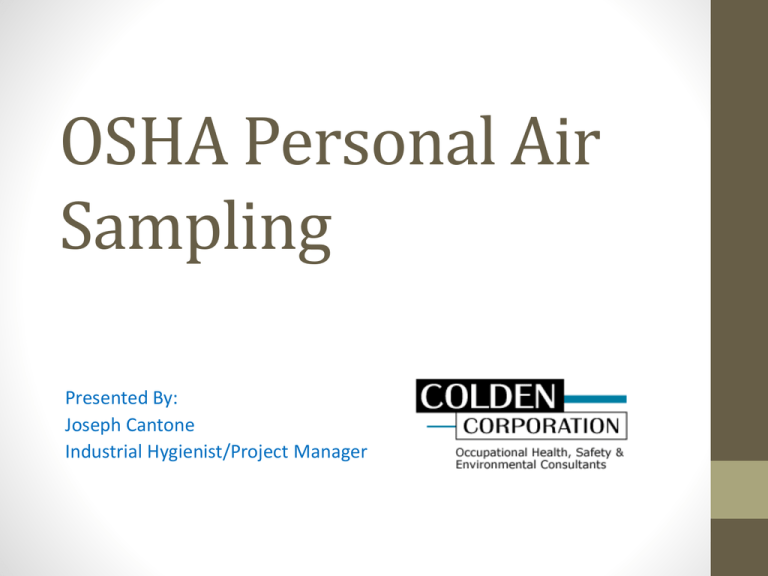
OSHA Personal Air Sampling Presented By: Joseph Cantone Industrial Hygienist/Project Manager • Background • Regulatory Requirements • Sampling Equipment and Media • Standard Sampling Procedure • Sampling Results • Initial Exposure Assessment • Negative Exposure Assessment • Personal Sampling for Potential Exposures Other Than Asbestos • Conclusions and Questions PACNY Conference 2013 Introduction • OSHA sampling and analytical methods were developed to provide OSHA with validated methods to monitor workplace exposure to a wide variety of chemical substances. • What is the Permissible Exposure Limit (PEL) for asbestos? Employers must ensure that no employee is exposed to an airborne concentration of asbestos in excess of 0.1 fibers per cubic centimeter (f/cc) as an 8-hour timeweighted average (TWA). In addition, employees must not be exposed to an airborne concentration of asbestos in excess of 1.0 f/cc as averaged over a sampling period of 30 minutes. This is known as an Excursion Limit. PACNY Conference 2013 Background • Which asbestos operations must employers monitor and assess? Employers must assess all asbestos operations for the potential to generate airborne fibers, and use exposure monitoring data to assess employee exposures. Employers must also designate a competent person to help ensure the safety and health of their workers. • What is the function of a competent person? On all sites with asbestos operations, employers must designate a competent person- one who can identify asbestos hazards in the workplace and has the authority to correct them. PACNY Conference 2013 Background • Competent Person • This person must be qualified and authorized to ensure worker safety and health as required by Subpart C, General Safety and Health Provisions for Construction (29 CFR 1926.20). • This person must frequently inspect job sites, materials and equipment. • The competent person must attend a comprehensive training course for contractors and supervisors certified by the USEPA or a state approved training provider. PACNY Conference 2013 Background • Occupational Safety and Health Administration (OSHA) • 29CFR 1910.1001 (General Industry) • 29CFR 1926.1101 (Construction Industry) • Initial Exposure Assessment • Negative Exposure Assessment • New York State Department of Labor (NYSDOL) • Industrial Code Rule 56 (ICR56) PACNY Conference 2013 Regulatory Requirements • What is an initial exposure assessment? • To determine expected exposures, a competent person must perform an initial exposure assessment to assess exposures immediately before or as the operation begins. This person must perform the assessment in time to comply with all standard requirements triggered by exposure data or the lack of a negative exposure assessment and to provide the necessary information to ensure all control systems are appropriate and work properly. A negative exposure assessment demonstrates that employee exposure during an operation is consistently below the permissible exposure limit (PEL). PACNY Conference 2013 Initial Exposure Assessment • The initial exposure assessment must be based on the following criteria: • Results of employee exposure monitoring, unless a negative exposure assessment has been made; and • Observations, information, or calculations indicating employee exposure to asbestos, including any previous monitoring. Note: For Class I asbestos work, until employers document that employees will not be exposed in excess of the 8-hour TWA PEL and STEL, employers must assume that employee exposures are above those limits. PACNY Conference 2013 Initial Exposure Assessment • What is a negative exposure assessment? • For any specific asbestos job that trained employees perform, employers may show that exposures will be below the PELs (i.e., negative exposure assessment) through the following: • Objective data demonstrating that asbestos containing materials (ACMs), or activities involving it, cannot release airborne fibers in excess of the 8hour TWA PEL or STEL; PACNY Conference 2013 Negative Exposure Assessment • What is a negative exposure assessment? (continued) • Exposure data obtained within the past 12 months from prior monitoring of work operations closely resembling the employer's current work operations (the work operations that were previously monitored must have been conducted by employees whose training and experience were no more extensive than that of current employees, and the data must show a high degree of certainty that employee exposures will not exceed the 8-hour TWA PEL or STEL under current conditions); or PACNY Conference 2013 Negative Exposure Assessment • What is a negative exposure assessment? (continued) • Current initial exposure monitoring that used breathing zone air samples representing the 8-hour TWA and 30-minute Excursion Limit exposures for each employee in those operations most likely to result in exposures over the 8-hour TWA PEL for the entire asbestos job. PACNY Conference 2013 Negative Exposure Assessment Conduct IEA NEA is not allowed No Yes Competent person assess the job Do work practices and materials for current job closely resemble those of the IEA? No Yes Has less than 12 months elapsed since the IEA or last employee exposure monitoring Yes Competent person certifies that a NEA applies to the current job No PACNY Conference 2013 Are exposures less than the PEL and STEL? 56-9.2 Air Sampling Requirements. (a) Personal Air Sampling. Air sampling shall be performed in the worker’s breathing zone, by the asbestos contractor for his personnel, as required by current OSHA regulations. Who is required to conduct this sampling? A) The Asbestos Abatement Contractor B) The Air Sampling Technician PACNY Conference 2013 NYSDOL ICR56 Sampling Equipment and Media PACNY Conference 2013 • Low Volume Pump and Tubing • Primary Calibration Device • Bios Dry Cal • Buck Calibrator • Soap Bubble Burette • Secondary Calibration Device • Rotometer PACNY Conference 2013 Sampling Equipment and Media • • • • • Belts Clips Tubing Chain of Custody Packaging PACNY Conference 2013 Sampling Equipment and Media • The media required is Phase Contract Microscopy Cassettes (PCM) • The sampler must have a 25 mm opening with a cellulose ester filter with 0.8-μm pore size for personal sampling • The samplers are commonly referred to as “PCM Cassettes” PACNY Conference 2013 Sampling Equipment and Media • First determine what tasks will be performed that shift. • On a typical asbestos abatement job there are multiple tasks such as workers removing ACM, someone will be wetting the asbestos, others might be bagging up removed ACM, someone would be cleaning the work area. • Each specific task needs monitoring to determine occupational exposure level. It is the Employer’s responsibility to assess all asbestos operations for the potential to generate airborne fibers, and use exposure monitoring data to assess employee exposure. The Employer must also designate a competent to help ensure the safety and health of the workers. PACNY Conference 2013 Sampling Procedures Sampling Procedures • The pump must be pre-calibrated. Typical flow rates 1.0 to 3.0 liters per minute (lpm). WHY? • The pre-calibration may be done using a secondary calibration device known as a rotometer. However it should be noted that the New York State Department of Health (NYSDOH) requires that secondary calibration devices be calibrated against primary calibration devices such as Bios Dry Cals, Buck Calibrators or soap bubble burettes on a minimum of a quarterly basis. This is based on NYSDOH Laboratory Accreditation Requirements Title 10, Parts 55.2 and 55.3 of the New York State Official Compilation of Codes, Rules and Regulations (10 NYCRR 55.2 and 55.3). PACNY Conference 2013 • Pre-calibration of the sampling pump • The pump shall be placed on the worker, attached to a belt. The cassette shall be placed in the workers breathing zone. • The chain of custody should be filled out including sampling start time, flow rate (lpm) and workers information including name, and task. PACNY Conference 2013 Sampling Procedures • Upon conclusion of the work shift the pumps must be post calibrated with the rotometer. All pertinent information of what the employee did, including tasks during the work shift, type of ACM involved (TSI, surfacing, VAT etc.) should be included on the chain of custody. Average the pre and post calibration. • The samples should be packaged along with field blanks and the chain of custody. Submit a minimum of two (2) field blanks with each set of samples. The samples should be relinquished to a NYSDOH Environment Laboratory Approval Program (ELAP) laboratory. • The laboratory will analyze the samples utilizing the NIOSH 7400 method by PCM. PACNY Conference 2013 Sampling Procedures • When a worker exits the work area for lunch, cap the sample and turn off the pump. When the worker returns to the work area, put the pump back on the worker and resume sampling. Note the time the worker was not wearing the pump on the chain of custody. If a worker is not wearing his personal sample where else should the sample be run: A) On top of a ladder B) On top of the negative air machine C) Inside the cab of the Supervisor’s truck D) None of the above PACNY Conference 2013 Sampling Procedures Other Occupational Exposures • NIOSH Method 7300 • PEL 50 micrograms per cubic meter • Action Level 30 micrograms per cubic meter • Silica • NIOSH Method 7500 • PEL is calculated based on percentage of silica in sample • Hexavalent Chromium • OSHA Method ID-215 • PEL 5 micrograms per cubic meter • Action Level 2.5 micrograms per cubic meter • Potential high exposure when welding stainless steel PACNY Conference 2013 • Lead Other Occupational Exposures • Total Dust – NIOSH 0500 PEL is 15 milligrams per cubic meter • Respirable Dust – NIOSH 0600 is 5 milligrams per cubic meter • PCBs • NIOSH 5503 • OSHA has PELs for two types of PCBs • Chlorodiphenyl (54% Chlorine) 0.5 milligrams per cubic meter • Chlorodiphenyl (42% Chlorine) 1.0 milligrams per cubic meter PACNY Conference 2013 • Total and or Respirable Dusts Web Sites• OSHA.GOV • For NIOSH Manual of Analytical Methods• http://www.cdc.gov/niosh/docs/ For Questions about occupational exposures or sampling please contact a Certified Industrial Hygienist (CIH) an Industrial Hygienist (IH) or a Laboratory such as Galson Labs. PACNY Conference 2013 Information Joe Cantone Colden Corporation (315) 445-0847 Cantone@Colden.com WWW.Colden.com PACNY Conference 2013 Thank You!



